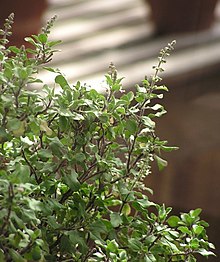Tulsi
| Ocimum tenuiflorum | |
|---|---|
 |
|
| Scientific classification | |
| Kingdom: | Plantae |
| (unranked): | Angiosperms |
| (unranked): | Eudicots |
| (unranked): | Asterids |
| Order: | Lamiales |
| Family: | Lamiaceae |
| Genus: | Ocimum |
| Species: | O. tenuiflorum |
| Binomial name | |
|
Ocimum tenuiflorum L. |
|
| Synonyms | |
|
|
Ocimum tenuiflorum, also known as Ocimum sanctum, holy basil, or tulasi or tulsi (also sometimes spelled thulasi), is an aromatic plant in the family Lamiaceae which is native to the Indian subcontinent and widespread as a cultivated plant throughout the Southeast Asian tropics. It is an erect, many-branched subshrub, 30–60 cm (12–24 in) tall with hairy stems and simple phyllotaxic green or purple leaves that are strongly scented.
Leaves have petioles and are , up to 5 cm (2.0 in) long, usually slightly toothed. The flowers are purplish in elongate racemes in close whorls. The two main morphotypes cultivated in India and Nepal are green-leaved (Sri or Lakshmi tulasi) and purple-leaved (Krishna tulasi).
Tulasi is cultivated for religious and medicinal purposes, and for its essential oil. It is widely known across the Indian subcontinent as a medicinal plant and a herbal tea, commonly used in Ayurveda, and has an important role within the Vaishnava tradition of Hinduism, in which devotees perform worship involving holy basil plants or leaves. This plant is revered as an elixir of life.
The variety of Ocimum tenuiflorum used in Thai cuisine is referred to as Thai holy basil (Thai: กะเพรา kaphrao); it is not to be confused with Thai basil, which is a variety of Ocimum basilicum.
DNA barcodes of various biogeographical isolates of Tulsi from the Indian subcontinent are now available. In a large-scale phylogeographical study of this species conducted using chloroplast genome sequences, a group of researchers from Central University of Punjab, Bathinda, have found that this plant originates from North Central India. The discovery might suggest the evolution of Tulsi is related with the cultural migratory patterns in the Indian subcontinent.
...
Wikipedia
